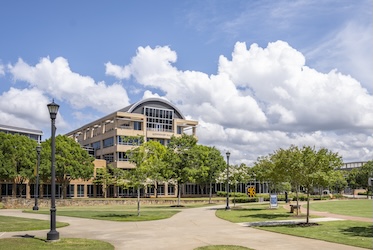

KENNESAW, Ga. | Dec 5, 2018
Institution’s total employment impact exceeded 14,000 in 2017
Kennesaw State University grew its total economic impact by more than $54 million and increased its total employment impact by 1,500 people in fiscal year 2017, according to a University System of Georgia report released this week. The total impact of all 26 USG institutions on their host communities was $16.8 billion in FY 2017, with Kennesaw State eclipsing $1.46 billion.
The University System’s measure of economic impact reflects direct and indirect spending that contributes to the regions served by its colleges and universities. According to the report, the sum of the direct, indirect and induced economic impacts is the total economic impact, and is expressed in terms of output (sales, plus or minus inventory), value added (gross regional product), labor income or employment.
Of Kennesaw State’s FY 2017 total economic impact, $917 million is initial spending by the institution for personnel services, operating expenses and student spending. The remaining $545 million of the output impact was created by re-spending – the multiplier effect of the dollars that are spent again in the region.
“This report confirms what so many of us already knew – Kennesaw State is an undeniable catalyst in growing our regional economy,” said President Pamela Whitten. “I am grateful for our talented students, faculty and staff who contribute directly and indirectly to their community as KSU continues building its reputation as a world-class institution.”
Serving nearly 36,000 students, Kennesaw State’s collective employment impact in FY 2017 was 14,441 full- and part-time jobs, including 3,911 jobs on campus, which created 10,530 jobs off-campus in either the private or public sectors.
The USG study was conducted by the Selig Center for Economic Growth in the University of Georgia’s Terry College of Business, which analyzed data collected between July 1, 2016, and June 30, 2017, to calculate the university’s economic impact.
“As we strive to graduate more students, keep college affordable and increase the efficiency in delivering education, it’s important to keep in mind that higher education is an investment, and from these numbers it’s a smart one,” Chancellor Steve Wrigley said. “Communities across our state and the state as a whole are benefiting from the economic engine that is the USG and its 26 institutions.”
Most of the $16.8 billion economic impact consists of initial spending by USG institutions for salaries and fringe benefits, operating expenses and other budgeted expenditures, as well as spending by the students who attended the institutions. Initial spending by USG institutions and students equaled approximately $11.5 billion, or about 68 percent of the total economic impact. The remaining $5.3 billion of the economic impact was created by re-spending.
The FY 2017 study found that the University System generated nearly 163,754 full- and part-time jobs – 3.7 percent of all jobs in Georgia, or about one job in 27. Approximately 31 percent of these positions are on campus as USG employees and 69 percent are off-campus positions in either the private or public sectors.
To download the University System of Georgia’s full economic impact report, go to: https://www.usg.edu/assets/usg/docs/news_files/USG_Impact_2017_%28November_2018%29.pdf.
– Travis Highfield

Rising above challenges marks inspiring career of President's Award of Distinction recipient

Lesley Netter-Snowden named executive vice president and chief business officer

Lawyers learning ethics lessons from AI mishaps, Kennesaw State speaker says

Kennesaw State designated a Military Spouse Friendly School by Viqtory
A leader in innovative teaching and learning, Kennesaw State University offers undergraduate, graduate, and doctoral degrees to its more than 51,000 students. Kennesaw State is a member of the University System of Georgia with 11 academic colleges. The university's vibrant campus culture, diverse population, strong global ties, and entrepreneurial spirit draw students from throughout the country and the world. Kennesaw State is a Carnegie-designated doctoral research institution (R2), placing it among an elite group of only 8 percent of U.S. colleges and universities with an R1 or R2 status. For more information, visit kennesaw.edu.